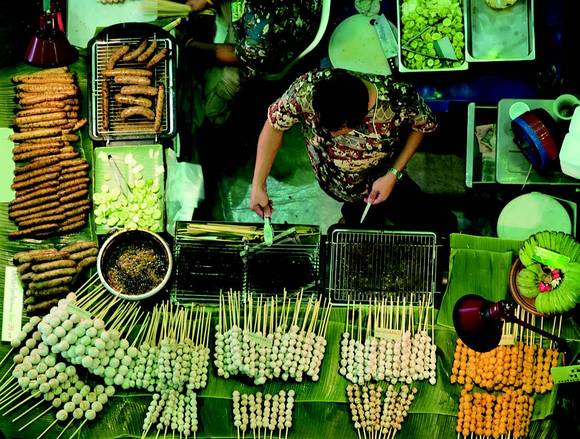Thailand Is Far Better Than the Media PR Suggests
If you read the newspapers or catch the news on the TV, you would think that Thailandwas imploding under the weight of political issues that seem impossible to resolve – yellow shirts fighting against red shirts sometimes leading to bombs, gunshots and deaths. The Thai people seem to accept these disputes and go about their daily lives as does the business community. Thailand is a big foodservice market with a large growing middle class and it would be unwise to ignore the opportunity because your management is scared off by all the violence one sees on CNN. I just returned from a two week business trip to Bangkok, Phuket and Chiang Mai working on a consulting assignment and my impressions were on the whole quite favorable.
만약 태국을 신문이나 TV뉴스에서 접했다면, 태국이 마치 절대 해결할 수 없는 정치적 문제로 자멸하고 있다고 여길지도 모른다. 붉은 셔츠를 입은 이들과 맞서 싸우는 노란 셔츠들은 때때로 폭탄이나 총성, 죽음으로 이어지기도 한다. 태국사람들이 이런 분쟁들을 받아들이고 업계사람들이 그러하듯이 일상생활을 계속해 나가는 것처럼 보인다. 그러나 태국은 거대한 요식업 시장인 동시에 막대한 중산층이 성장하고 있는 나라인 만큼 단지 CNN에서 나오는 폭력적인 장면에 경영진들이 겁을 먹고 기회를 무시하는 처사는 어리석은 행동일지도 모른다. 방콕과 푸켓, 치앙마이에서 보낸 2주일간의 컨설팅 출장에서 느낀 바는 상황이 꽤나 순조롭다는 점이다.
Foodservice Market is Large and Still Growing
여전히 거대하며 성장하고 있는 요식시장
The Thailand foodservice market is $22 Billion and has compound growth during the 2007-2012 period of 2.4% per year. This compares favorably to the Philippines ($10 Billion) and Malaysia ($10 Billion) but below Indonesia ($39 Billion) with more than 3.5 times the population. Western restaurant concepts have done very well over the years. KFC had 457 stores in 2012, McDonald’s 169, and Starbucks 165. The convenience chain 7-Eleven has almost 7000 units throughout the country. The population of 69 million creates a large consumer market for all food products and foodservice providers.
태국 요식시장의 규모는 220억 달러에 달하며 2007~2012년 동안 연평균 2.4%씩 성장했다. 규모만 놓고 보면 필리핀(100억 달러)이나 말레이시아(100억 달러)보다 유리하지만 3.5배의 인구를 지닌 인도네시아(390억 달러)보다는 못하다. 서방 요식업 프랜차이즈들은 수년간에 걸쳐 우수한 성과를 거둬왔다. 2012년 기준으로 KFC는 457개 매장, 맥도날드는 169개, 스타벅스는 165개 매장을 운영 중이다. 세븐일레븐 같은 편의점 체인이 전국에 운영하는 지점만 거의 7000개에 달한다. 6900만 명의 인구가 빚어낸 모든 요식업자와 식료품들을 위한 시장인 셈이다.
There are over 170 malls in the country providing good retail locations for leading local and international chains. The key cities of Bangkok, Chiang Mai, Phuket and Hat Yai provide good expansion potential for concepts that are well accepted by the mass consumer.
전국적으로 다국적 및 유망한 지역 프랜차이즈들에게 좋은 판매장소를 제공할 쇼핑몰만 170여 개나 된다. 방콕, 치앙마이, 푸켓, 핫야이 같은 핵심 도시들의 경우 대중적으로 인기 있는 요식업 프랜차이즈에게 우수한 확장 가능성을 제공하고 있다.
Household Incomes Are Still Low!
가계소득은 여전히 낮다!
Like most emerging markets in Asia, household incomes are quite low - $3,276 in 2011, which is almost double the Philippines but well below Malaysia at $5,234. QSR and low priced full service restaurants that cater to the mass market have the best growth potential but the scale of Starbucks suggest that aspirational concepts viewed as affordable luxuries can also do well. We estimate that approximately 65% of the adult population can afford QSR and about 49% of them dine on occasion at restaurants where average spending is $10 or less per person.
다른 아시아 신흥시장과 마찬가지로 가계소득은 여전히 낮다. 2011년 기준으로 3276달러로 필리핀의 두 배 수준이나 같은 기간 5234달러를 기록한 말레이시아에 비하면 한참 낮다. 그러므로 대중들의 입맛에 맞는 퀵서비스 레스토랑(QSR)이나 다른 저가형 풀 서비스 레스토랑입장에서 최고의 성장 잠재력을 지니고 있으며 스타벅스처럼 다소 고급스러운 매장도 물론 성공할 수 있다. 성인 인구의 약 65%는 QSR을 이용할 수 있을 형편이며 49%는 때때로 인당 평균 10달러 혹은 그 미만으로 식사하는 식당에 출입할 수 있다고 추정된다.
Tourists Are A Big Factor
관광객이 큰 변수
Thailand received over 22 million tourists in 2012 who visited Bangkok, Chiang Mai as well as the beach resorts such as Pattaya, Phuket and Samui. These tourists have a big influence on foodservice spending especially for western concepts. There are many successful restaurant brands doing very well just living off the tourist trade both local Thai and foreign.
2012년 기준으로 방콕이나 치앙마이를 비롯해 파타야나 싸무이 등 해변 리조트를 찾은 해외 관광객만 2200만 명으로 추산된다. 특히 이들 관광객들은 서방 요식프랜차이즈 영업에 막대한 영향을 끼친다. 현지관광객 및 외국 관광객들을 상대로 우수한 영업실적을 올리고 있는 프랜차이즈들도 많다.
Japanese Food Still Dominates
아직까지는 일식이 주류
Visiting the major cities of Thailand, it is very common to see many Asian concepts but very few western full service restaurants. Japanese food is everywhere, with the leading local chains, Fuji and Yayoi having 94 and 82 locations respectively nationwide. I saw very few Korean restaurants and my impression is that they cater primarily to Korean businessmen and tourists. We did see some Korean coffee chains like Tom n Toms on our travels. Over 1.2 million Korean tourists visit Thailand each year and the numbers are growing. Surprisingly there are no major chains directly from Japan or Korea operating in the market today with any scale other than the bread company, Yamazaki.
태국 대도시를 방문할 때, 아시아계열 프랜차이즈는 쉽게 찾을 수 있지만 서방에서 들어온 풀 서비스레스토랑을 찾긴 어렵다. 유망한 지역 프랜차이즈를 중심으로 일식을 어디서나 만날 수 있으며 후지나 야요이 같은 브랜드는 전국에 걸쳐 각각 94개, 82개 매장을 운영 중이다. 몇 안 되는 한국 식당도 본 적이 있지만 대부분 한국 출장객이나 관광객들을 대상으로 영업하고 있었다. 탐앤탐스 같은 한국 커피 프랜차이즈도 본 적이 있다. 매년 120만명에 달하는 한국 관광객들이 태국을 찾고 있고 꾸준히 늘어나는 추세다. 놀랍게도 현재 태국에서 일본 야마자키 같은 단일 브랜드 회사를 제하고는 한국 및 일본 대형 프랜차이즈 직영점은 전무한 형편이다.
Niche Markets are Growing Quickly
빠르게 성장하는 틈새시장 Urban Thai’s are demanding more convenient ways to get their food so delivery and take-away are growing more than 10% per year in addition to convenience stores. High end alcoholic beverages such as wine are also exhibiting very strong growth exceeding 10% per year as young urban professional workers aspire to a more western lifestyle.
Urban Thai’s are demanding more convenient ways to get their food so delivery and take-away are growing more than 10% per year in addition to convenience stores. High end alcoholic beverages such as wine are also exhibiting very strong growth exceeding 10% per year as young urban professional workers aspire to a more western lifestyle.
배달음식점이나 테이크아웃 음식점들은 태국 도심지를 중심으로 보다 간편한 음식을 찾는 수요가 증가하다 보니 편의점 증가와 더불어 매년 10%이상 늘고있다. 뿐만 아니라 서구식 생활방식을 추종하는 젊은 도시 전문직 인구가 많아지면서 와인 같은 고급 알코올음료 시장도 매년 10%씩 성장하고 있다.
There are Plenty of Opportunities Remaining for Overseas Concepts
해외 프랜차이즈들을 위한 기회도 여전히 많다.
Non- Thai concepts tend to offer everything on the menu so there is still plenty of room for highly focused brands doing a few things well to succeed in the marketplace. For example, the Japanese chains, Yayoi and Fuji, specialize in sushi but sell noodles, tempura, tonkatsu and many other menu items. Chains focusing only on tonkatsu, tempura or ramen for example should do very well going forward. We also believe there is still a big growing market for coffee chains which can provide unique potential for Asian concepts with their special Japanese or Korean menu and design. There is room for higher quality gourmet pizza brands as well as better burger ideas. Chinese QSR and affordable family dining should also do well.
비태국계 프랜차이즈들은 다양한 메뉴를 제공하는 경향이 있기 때문에 특정 메뉴에 특화된 브랜드라도 시장에서 충분히 성공할 수 있다. 예를 들어 후지나 야요이같은 일본 프랜차이즈는 초밥에 특화되어 있지만 면이나 덴뿌라, 돈까스 같은 다양한 메뉴들도 같이 팔고 있다. 돈까스나 덴뿌라, 라멘에 특화된 프랜차이즈라도 영업하는데 지장이 없을 것이다. 커피분야에서도 일본식 혹은 한국식 메뉴를 갖춘 독특한 잠재력을 가진 아시아 프랜차이즈라면 찾는 이들이 많을 것이라고 믿는다. 미식가들을 위한 고급 피자 브랜드나 고품격 햄버거 업장를 위한 시장도 있다. 중국식 QSR이나 저렴한 패밀리레스토랑도 분명히 잘해나갈 수 있을 것이다.
Is there room for Korean brands to prosper in the Thai market? Most definitely the answer is yes. First, I believe the best short term opportunity is coffee and bakery. Korea is such an intensely competitive market which has led to many innovative ideas from CJ and SPC to mention a few. I am confident that brands like Paris Croissant and Tous Les Jours will do well over time. I am not so certain about all the copy cat coffee brands that are struggling already in the Korean market and have nothing really unique to offer. Second, inexpensive Korean street food will receive strong appeal from urban consumers. Thai people are adventurous eaters and love spicy foods. Finally, I believe there will be a growing market for Korean stews and soups like budae jjigae, sundubu jjigae and chul pan.
태국시장에서 한국브랜드들이 번창할 공간이 있을까? 대답은 당연히 ‘그렇다’이다. 우선 단기적으로 최고의 사업영역은 커피와 제과영역이다. 한국 시장은 CJ나 SPC같은 업체들이 혁신적인 아이디어로 이끌어온 매우 경쟁력 있는 시장이다. 파리크라상이나 뚜레쥬르 같은 브랜드들은 태국에서도 잘해나갈 것이라고 확신한다. 다만 한국 시장에서 이미 진흙탕싸움을 거듭하며 사실 특별하지도 않은 수많은 유사 커피브랜드들의 경우 딱히 확신하긴 어렵다. 두 번째로 저렴한 한국 길거리 음식은 태국 도시소비자들을 단숨에 휘어잡을 것이다. 태국 사람들은 새로운 음식에 도전할 때 거리낌이 없으며 매운 음식을 좋아하기 때문이다. 마지막으로 태국에서도 부대찌개나 순두부찌개, 철판요리처럼 한국식 국이나 찌개를 찾는 시장이 성장할 전망이다.
When I went to dinner at night in Bangkok I could see many of the protestors taking a break from their activities to share a meal with friends and family. There are no yellow shirts or red shirts when it comes to good food!
저녁 무렵 방콕에 갔을 때 많은 시위자들이 쉬면서 친구와 가족들과 함께 식사를 하는 장면을 볼 수 있었다. 맛있는 음식 앞에서는 노란셔츠도, 빨간셔츠도 없었다!
<2014년 3월 게재>
조엘 실버스테인 Joel Silverstein
이스트웨스트 호스피탤리티 그룹 대표
President of The East West Hospitality Group
조엘 실버스테인 대표는 장기간 아시아 퍼시픽 지역에 살며 최고 경영진과 포춘(Fortune) 500대 기업이 중국, 홍콩, 일본, 한국 외 다수 아시아 국가에서 지속 가능한 성장을 할 수 있게 도와주었다. 실버스테인 대표는 호스피탤리티 산업의 전 경영진으로서 주요 언론 매체를 통해 중국 동남아시아의 프랜차이즈, 아시아에서의 비즈니스 관행, 역동적인 이머징 마켓과 관련된 주제로 빈번하게 기고하였다. 현재 홍콩에 거주하며, 자주 인근 아시아 지역 뿐만 아니라 미국, 유럽, 아프리카 지역까지 여행한다.
- 2024.11.05(화)~2024.11.11(월) 투어리즘&마이스 서울특별시관광협회, 제27대 협회장 후보자 등록 실시
- 2024.10.25(금)~2024.11.07(목) 대회·공모전 "서울 관광산업 발전에 기여한 자를 찾습니다."…서울특별시관광협회(STA), 2024 서울관광대상 수상 후보자 모집
- 2024.10.18(금)~2024.10.19(토) 축제 한국관광공사, 원주 시민과 함께하는 ‘세계로(路) 페스타’개최
- 2024.10.13(일)~2024.10.20(일) 축제 하슬라국제예술제 오는 13일 개막… 공연장으로 탈바꿈한 강릉 정체성 담긴 장소들
- 2024.10.5(토)~2024.11.3(일) 축제 대한민국 대표 공연관광 축제 ‘2024 웰컴대학로’ 개최
- [Joel의 Global Dining Market] 로보틱스, 자동화의 시대가 도래하다 2021-06-15
- [Joel의 Global Dining Market] 가상공간의 외식 브랜드 시장 속에 실재할 수 있을까? 2021-04-05
- [Joel의 Global Dining Market] 뉴노멀에 적응하는 식당가들의 새로운 전략_ 배달음식 전문점 2020-11-12
- [Joel의 Global Dining Market] 해외 진출의 관문? 홍콩 시장의 인기_ 외식업계 위기와 변화 면밀히 살펴봐야 2020-09-20
- [Joel의 Global Dining Market] 코로나19의 여파, 미국 외식 산업의 위기_ 더 좋은 음식과 더 나은 서비스로 고객 공략해야 2020-08-03
- [Joel의 Global Dining Market] 코로나19로 기세 오른 플랫폼 비즈니스_ 레스토랑과 상생하는 모델 모색해야 2020-06-02
- [Joel의 Global Dining Market] 아픈 손가락의 성장 필리핀 2020-04-20
-

호텔컨설팅연구소(Hotel Consulting Lab), 트레블로지 호텔스(아시아)와 MOU 협약식 가져
- 2024-11-20
- 서현진 기자
-

엔포드 호텔, ‘더 라운지 리힛트 21’ 12월 공식 오픈
- 2024-11-20
- 서현진 기자
-

‘나만 알고싶은 영화관’ MONOPLEX@RYSE, 11월 20일 홍대 라이즈호텔에 그랜드 오픈
- 2024-11-20
- 안수진 기자
-

제주항공, 신분할인 대상자 탑승절차 간소화
- 2024-11-20
- 안수진 기자
-

한국할랄산업연구원, 할랄관광평가사 양성과정 온라인 교육 론칭
- 2024-11-20
- 호텔앤레스토랑
-

[F&B TREND] 북미 시장 트렌드 ① 아이스티 소비 강국, 미국
- 2024-11-20
- 정승호 칼럼니스트






























